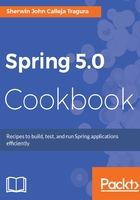
What this book covers
Chapter 1, Getting Started with Spring, is the installation and configuration section of the book. It consists of recipes that enumerate the steps on how to install Java 1.8, Tomcat 9 with TLS, Eclipse STS 8.3, MySQL 5.7, and MongoDB 3.2. This will also provide a procedure on how to build a Maven project with Spring 5 dependencies and deploy it using the Tomcat Maven plugin.
Chapter 2, Learning Dependency Injection (DI), covers the core concepts of Inversion of Control (IoC) design pattern. This chapter provides recipes on how to build ApplicationContext through XML-based configurations and the JavaConfig specification. You will also be guided on how to perform a @Bean injection and autowiring. Most importantly, this chapter will highlight the role of IoC in building Spring MVC web applications.
Chapter 3, Implementing MVC Design Pattern, highlights the construction of Spring 5 web applications based on its Spring WebMvc module. This will provide recipes that aim to implement the controller, service, and DAO layers with some supporting features such as view resolvers, message bundles, and JDBC connectivity.
Chapter 4, Securing Spring MVC Application, is all about Spring Security integration with Spring 5. The chapters that use Spring MVC will be applying Spring Security 4, while those that implement th Spring WebFlux module will be using Spring Security 5 with asynchronous and reactive transactions. Advance topics such as protection against Cross-Site Request Forgery (CSRF), session fixation, and cross-site scripting (XSS) and Clickjacking will also be covered in some recipes.
Chapter 5, Cross-Cutting the MVC, contains recipes that discuss implement aspects, advices, and pointcuts. The aspect-object programming paradigm will be thoroughly discussed, focusing on how it will be used across the Spring 5 platform. Concepts such as improvised security, validating method parameters, monitoring @Controller request transactions, and interception will also be included in the recipes.
Chapter 6, Functional Programming, contains recipes that will layout the foundation of functional programming paradigm in Spring 5. This will showcase the Stream API of Java 1.8 and its threaded operations being applied to the service layer of the platform. Topics such as sequential and parallel streams will be covered here.
Chapter 7, Reactive Programming, focuses on Spring 5 integration with the Reactor Core module. The recipes of this chapter will apply Publisher<T> and Subscriber<T> from the reactive stream specification in order to generate reactive data streams with short-lived and continuous stream flows. Also included are implementations of asynchronous transactions using @Async, Callable<T>, and DeferredResult<T>. Apart from Reactor Core, this chapter will also include other reactive libraries such as RxJava 2.0 used in building the reactive service layer of Spring 5.
Chapter 8, Reactive Web Applications, is where we start using Reactor Core in building reactive web applications. This includes recipes that use Publisher<T>, Flux<T>, and Mono<T> in building the service and the @Controller layer. Some recipes also discuss how to implement Callable<T> and DeferredResult<T> response transactions. In this chapter, some view resolvers will be introduced to recognize reactive streams.
Chapter 9, Spring Boot 2.0, discusses how to build and deploy Spring MVC and Spring WebFlux projects using Spring Boot 2.0. It is only in this chapter that the functional and reactive web framework of Spring 5 will be completely implemented using the HandlerFunction<T> and RouterFunction<T> reactive components executed by the Reactor Netty server.
Chapter 10, The Microservices, applies the concept of functional and reactive web framework to microservices. This provides a set of recipes that will showcase the strength of Spring Boot 2.0 in building and consuming synchronous, asynchronous, and reactive services in a microservice. In the chapter, we will cover the procedure to implement a loosely-coupled microservices setup through the Eureka server or Docker.
Chapter 11, Batch and Message-Driven Processes, talks about how to implement a totally loosely-coupled microservices through message-driven transactions. There are also recipes that will discuss on how to implement background batch processes using Spring Batch and Spring Cloud Task.
Chapter 12, Other Spring 5 Features, is one of the most important chapters in this book because it showcases other reactive and non-reactive components of Spring 5 that are not mentioned in the previous chapter but are useful to professionals. In this chapter, there are recipes dedicated to how to enable Hibernate 5, WebSocket, and HazelCast caching. Also, there are others written to showcase the reactive features of Spring 5 such as Spring Data JPA, Spring Data MongoDB, and Kotlin.
Chapter 13, Testing Spring 5 Components, highlights the Spring TestContext framework and how it is utilized in testing synchronous, asynchronous, and reactive Spring components such as native and REST services, repositories, JPA transactions, controllers, and views.